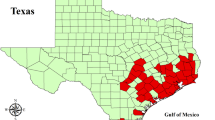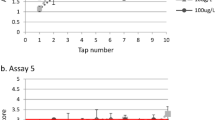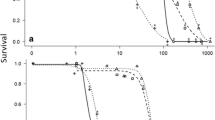Abstract
Diffubenzuron (Dimilin) is used as an insecticide for control of the gypsy moth. Because it is a chitin synthetase inhibitor, it can be a potential threat to other arthropods, including crustaceans. We used a static renewal testing paradigm to determine the LC50 of Dimilin WP-25 to juvenile blue crabs (carapace width: 25–60 mm). Both molt stage of dose frequency effect toxicity. When we exposed the crabs at random molt stages, LC50=3.5 mg l−1. When crabs were exposed on the day of molt, LC50=300 μg l−1. If initial exposure occurred on the day of molt and the crabs were subsequently exposed to repeated doses, LC50=18.5 μg l−1. Effects were age and molt-stage sensitive. We include a review of the data available on Dimilin effects in the marine and estuarine environments.
Similar content being viewed by others
Literature Cited
Ali, A. and M. L. Kok-Yokomi. 1989. Field studies on the impact of a new benzoylphenylurea insect growth regulator (UC-84572) on selected aquatic nontarget invertebrates. Bulletin of Environmental Contamination and Toxicology 42:134–141.
Bookhout, C. G., A. J. Wilson, Jr., T. W. Duke, and J. I. Lowe. 1972. Effects of mirex on the larval development of two crabs. Water Air and Soil Pollution 1:165–180.
Cameron, J. N. 1985. Molting in the blue crab. Scientific American 252:102–109.
Chockalingam, S. and M. Krishnan. 1984. Effects of sublethal doses of diflubenzuron on energy budget of Ergolis merione (Lepidoptera: Nymphalidae). Entomon 9:121–126.
Chistiansen, M. E. and J. D. Costlow, Jr. 1982. Ultrastructural study of the exoskeleton of the estuarine crab Rhithropanopeus harrisii: Effect of the insect growth regulator Dimilin (diflubenzuron) on the formation of the larval cuticle. Marine Biology 66:217–226.
Christiansen, M. E., J. D. Costlow, Jr., and R. J. Monroe. 1978. Effects of the insect growth regulator Dimilin (TH 6040) on larval development of two estuarine crabs. Marine Biology 50:29–36.
Chrisiansen, M. E., E. Gosling, and M. A. Williams. 1984. Effect of the insect growth regulator diflubenzuron (Dimilin) on the uptake of glucose and N-acetylglucosamine into the cuticle of crab larvae. Marine Biology 83:225–230.
Costlow, J. D. 1979. Effect of Dimilin on development of larvae of the stone crab. Menippe mercenaria, and the blue crab, Callinecles sapidus, p. 355–363. In W. B. Vernherg, A. Calabrese, F. P. Thurberg, and F. J. Vernberg (eds.), Marine Pollution: Functional Responses. Academic Press, Inc., New York.
Costlow, J. D., Jr. and C. G. Bookhout. 1959. The larval development of Callinectes sapidus Rathbun reared in the laboratory. Biological Bulletin 116:373–396.
Cunningham, P. A. 1976. Effects of Dimilin (TH-6040) on reproduction in the brine shrimp, Artemia salina. Environmental Entomology 5:701–706.
Cunningham, P. A. 1986. A review of toxicity testing and degradation studies used to predict the effects of diflubenzuron (Dimilin) on estuarine crustaceans. Environmental Pollution (Series A) 40:63–86.
Cunningham, P. A. and L. E. Myers. 1986. Dynamics of diflubenzuron (Dimilin) concentrations in water and sediment of a supratidal saltmarsh site following repetitive aerial applications for mosquito control. Environmental Pollution (Series) 41:63–88.
Cunningham, P. A. and L. E. Myers. 1987. Effects of diflubenzuron (Dimilin) on survival, molting, and behavior of juvenile fiddler crabs, Uca pugilator. Archives of Environmental Contamination and Toxicology 16:745–752.
Cunningham, P. A., J. E. H. Wilson, D. W. Evans, and J. D. Costlow, Jr. 1987. Effects of sediment on the persistence and toxicity of diflubenzuron (Dimilin) in estuarine waters: A laboratory evaluation using larvae of two estuarine crustaceans, p. 299–332. In W. B. Vernberg, A. Calabrese, F. P. Thurberg, and F. J. Vernberg (eds.), Pollution Physiology of Estuarine Organisms. Academic Press, Inc., New York.
Downey D. M. 1989. Analysis of diflubenzuron in stream water samples from Little Sluice Mountain gypsy moth sprayblock. United States Forest Service, James Madison University, Harrisonburg, Virginia.
Fischer, R. A. and L.W. Hall, Jr. 1992. Environmental concentrations and aquatic toxicity data on diflubenzuron (Dimilin). Critical Reviews of Toxicology 22:45–79.
French, D. P. and S. Rebach. 1991. Dimilin the estuarine environment: Toxic effects of Chesapeake Bay blue crab. Proceedings of the Annual Gypsy Moth Review 1991:47–54.
Gulka, G., C. M. Doscher, and N. Watabe. 1980. Toxicity and molt-accelerating effects of diflubenzuron on the barnacle, Balanus eburneus. Bulletin of Environmental Contamination and Toxicology 25:477–481.
Gwinn, J. F. and J. R. Stevenson. 1973. Role of acetylglucosamine in chitin synthesis in crayfish. I. Correlation of 14C-acetylglucosamine incorporation with stages of the molting cycle. Comparative Biochemistry and Physiology 45B:769–776.
Hester, P. G., T. G. Floore, and M. A. Olson. 1985. Effects of difflubenzuron on three estuarine decapods, Callinectes sp., Palaemonetes pugio, and Uca pugilator. Journal of the Florida Anti-Mosquito Association 56:8–14.
Hines, A. H., R. N. Lipicius, and A. M. Haddon. 1987. Population dynamics and habitat partitioning by size, sex, and molt stage of blue crabs (Callinectes sapidus) in a subestuary of central Chesapeake Bay. Marine Ecology Progress Series 36:55–64.
Huber, C. M. and D. L. Collins. 1987. Final report on the 1987 spray project to eradicate gypsy moth from the Tusquitee Ranger District oN the Nantahala National Forest. United States Forest Service, Ashville Field Office, Asheville, North Carolina.
Huber, C. M. and E. H. Manchester. 1988. Final report on the eradication of the gypsy moth from the Tusquitee Ranger District on the Nantahala National Forest. United States Forest Service, Asheville Field Office, Asheville, North Carolina.
Ivie, G. W., D. L. Bull, and J. A. Veech 1980. Fate of diflubenzuron in water. Journal of Agricultural and Food Chemistry 28:330–337.
Jones, A. S. and J. N. Kochenderfer. 1987. Persistence of diflubenzuron in a small eastern watershed and its impact on invertebrates in a headwater stream. United States Forest Service, Southeastern Forest Experiment Station, Research Triangle Park, North Carolina.
Laughlin, R. A. 1982. Feeding habits of the blue crab, Callinectes sapidus, in the Apalachicola Estuary, Florida. Bulletin of Marine Science 32:807–822.
Lawrie, C. D. 1990. The fate of the insecticide diflubenzuron in the Patuxent River. M.S. thesis, University of Maryland, College Park, Maryland.
Leighton, T., E. Marks, and F. Leighton. 1981. Pesticides: Insecticides and fungicides and chitin synthesis inhibitors. Science 213:905.
Lippson, A. J. (ed.) 1973. The Chesapeake Bay in Maryland: An atlas of natural resources. Johns Hopkins University Press, Baltimore, Maryland.
McClintock, J. B., T. S. Klinger, K. Marion, and P. Hsueh. 1991. Digestive carbohydrases of the blue crab, Callinectes sapidus (Rathbun): Implications in utilization of plant-derived detritus as a trophic resource. Journal of Experimental Marine Biology and Ecology 148:233–239.
Millikin, M. R. and A. B. Williams. 1984. Synopsis of biological data on the blue crab, Callinetes sapidus Rathbun. National Oceanic And Atmospheric Administration Technical Report NMFS 1. Washington, D.C.
Nimmo, W. B., A. G. M. Willems, K. D. Joustra, and A. Verloop. 1986. The degradation of diflubenzuron and its chief metabolites in soils. II. Fate of 4-chlorophenyl urea. Pesticide Science 17:403–411.
Post, L. C., B. J. de Jong, and W.R. Vincent. 1974. 1-(2,6-disubstituted benzoyl)-3-phenylurea insecticides: Inhibitors of chitin synthesis. Pesticide Biochemistry and Physiology 4:473–483.
Pritchard, P. H., A. W. Bourquin, H. L. Fredrickson, and T. Maziarz. 1979. System design factors affecting environmental fate studies in microcosms, p. 251–272. In A. W. Bourquin and P. H. Pritchard (eds.), Workshop: Microbial Degradation of Pollutants in Marine Environments. United States Environmental Protection Agency, Washington, D.C.
Rebach, S. 1981. Pelletized diet for rock crabs. Progressive Fish Culturist 43:148–150.
Rodrigues, C. S. and N. K. Kaushik. 1986. Laboratory evaluation of the insect growth regulator diflubenzuron against black fly (Diptera: Simuliidae) larvae and its effects on non-target stream invertebrates. The Canadian Entomologist 118: 549–558.
Savitz, J. 1991. Toxic effects of the insecticide diflubenzuron (Dimilin) on survival and development of the estuarine copepod, Eurytemora affinis. M.S. thesis, University of Maryland, College Park, Maryland.
Schaefer, C. H. and E. F. Dupras, Jr. 1976. Factors affecting the stability of Dimilin in water and the persistence of Dimilin in field waters. Journal of Agricultural and Food Chemistry 24: 733–739.
Schimmel, S. C., R. L. Garnas, J. M. Patrick, and J. C. Moore. 1983. Acute toxicity, bioconcentration, and persistence of AC 222,705, Benthiocarb, Chlorpyrifos, Fenvalerate, Methyl Parathion, and Permethrin in the estuarine environment. Journal of Agricultural and Food Chemistry 31:104–113.
Smucker, R. A. 1987. Environmental residues of Dimilin as a consequence of aerial spraying for gypsy moth control. Final report to Gypsy Moth Control, Maryland Department of Agriculture, Annapolis, Maryland.
Smucker, R. A. 1988. Environmental residues of Dimilin as a consequence of aerial spraying for gypsy moth control. Final report to Gypsy Moth Control, Maryland Department of Agriculture, Annapolis, Maryland.
Stevenson, J. R. 1985. Dynamics of the integument, p. 1–42. In D. E. Bliss and L. H. Mantel (eds.), Integument, Pigments, and Hormonal Processes, Vol. 9. The Biology of Crustacea. Academic Press, New York.
Stoner, A. W. and B. A. Buchanan. 1990. Ontogeny and overlap in the diets of four tropical Callinectes species. Bulletin of Marine Science 46:3–12.
Tagatz, M. E. 1968. Growth of juvenile blue crabs, Callinectes sapidus Rathbun, in the St. Johns River, Florida. Fisheries Bulletin 67:282–288.
Tester, P. A. and J. D. Costlow. 1981. Effect of the insect growth regulator Dimilin (TH-6040) on fecundity and egg viability of the marine copepod Acartia tonsa. Marine Ecology Progress Series 5:297–302.
Touart, L. W. and K. R. Rao. 1985. Influence of diflubenzuron on survival, molting, and limb regeneration in the grass shrimp, Palaemonetes pugio, p. 333–339. In W. B. Vernberg, A. Calabrese, F. P. Thurberg, and F. J. Vernberg (eds.), Pollution Physiology of Estuarine Organisms. Univeristy of South Carolina Press, Columbia, South Carolina.
United States Environmental Protection Agency. 1982. Chesapeake Bay: Introduction to an Ecosystem. United States Environmental Protection Agency, Washington, D.C.
United States Environmental Protection Agency. 1985. Pesticide fact sheet: Diflubenzuron, #68, Office of Pesticides Programs, United States Environmental Protection Agency, Washington, D.C.
Van Engel, W. A. 1958. The blue crab and its fishery in the Chesapeake Bay. Part 1—Reproduction, early development, growth, and migration. Commercial Fisheries Review 20:6–17
Verloop, A. and C. D. Ferrell. 1977. Benzoylphenyl ureas—A new group of larvicides interfering with chitin deposition, p. 237–270. In J. R. Plimmer (ed.), Pesticides in the Twentieth Century. ACS Symposium Series, No. 37. American Chemical Society, Washington D. C.
Weis, J. S. and A. Ma. 1987. Effects of the pesticide diflubenzuron on larval horseshoe crab, Limulus polyphemus. Bulletin of Environmental Contamination and Toxicology 39:224–228.
Weis, J. S., R. Cohen, and J. K. Kwiatkowski. 1987. Effects of diflubenzuron on limb regeneration and molting in the fiddler crab Uca pugilator. Aquatic Toxicology 10:279–290.
Wilson, J. E. H. and J. D. Costlow. 1986. Comparative toxicity of two Dimilin formations to the grass shrimp, Palaemonetes pugio. Bulletin of Environmental Contamination and Toxicology 36: 858–865.
Wilson, J. E. H. and J. D. Costlow. 1987. Acute toxicity of diflubenzuron (DFB) to various life stages of the grass shrimp, Palaemonetes pugio. Water Air and Soil Pollution 33:411–417.
Author information
Authors and Affiliations
Corresponding author
Rights and permissions
About this article
Cite this article
Rebach, S., French, D.P. Effects of dimilin on the blue crab, Callinectes sapidus, in shallow-water habitats. Estuaries 19, 279–287 (1996). https://doi.org/10.2307/1352233
Received:
Accepted:
Issue Date:
DOI: https://doi.org/10.2307/1352233




